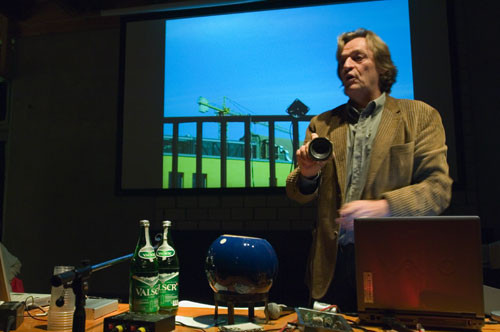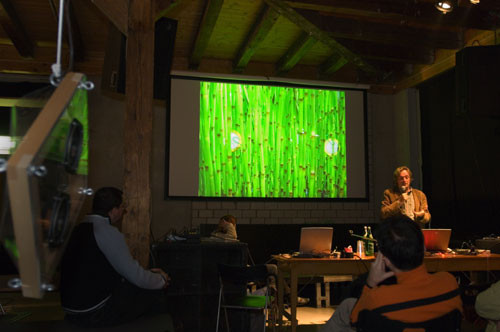
Event
Donnerstag 01.12.2005
Dorkbot Meeting
20.00 uhr
andrès bosshard
"die klangwettermacher“
was wir in nächster zukunft mit sounds machen werden
karel kulhavy
"twibright ronja“
diy optical wireless datalink 10mbps/1.4km
ronja.twibright.com
tian lutz
"readable“
what happens if body data gets translated and displayed by a wearable (smart object). does this information change interhuman communication?
22:00 uhr
sonik splinter + post-meeting sheik-control:
agnella toxica - clang collaps
About Ronja ronja.twibright.com
Ronja is a free technology project of reliable optical data link with current range 1.4km and current communication speed 10Mbps full duplex.
Applications of this wireless networking device include backbone of free, public, and community networks, individual and corporate Internet connectivity, and also home and building security. High reliability and availability link is possible in combination with WiFi devices. Twibright Ronja datalink can network neighbouring houses with cross-street ethernet access, solve the last mile problem for ISP, or provide link layer for fast neighbourhood mesh networks.
Ronja (Reasonable Optical Near Joint Access) is an Free Technology (like Free Software) project of optical point-to-point data link. The design is released under the GNU General Public License: you get all the necessary documentation and construction guides free. The construction costs are minimal; it's probably the cheapest wireless system ever. The operation is reliable and immune to interference.
Ronja project is a project from the realm of free technology. Free technology is free as speech, not free as beer. It means that for everything released, a full source code (form most suitable for editing) is available.
Output of Ronja project is a design, Twibright Labs' intent is not to manufacture and sell pieces of hardware. If you run into troubles following the guides, there is an end-user-oriented support provided in the form of mailing list.
The device is suitable for
* People who need the device and have time to build it
* People who want to manufacture the device commercially and don't mind the fact that the source codes are available to the public
* People that need the device, don't have the time to build it but have money to pay some wright to build it for them according to the building guide.
One Ronja device is a single long-distance optical transceiver that is capable of running against the same or compatible device on the other side of the link. The topology is point-to-point.
Building a Ronja is rather lenghty job (this will hopefully change in future) that however pays off in a reliable and performant device that is capable of delivering steady connectivity with little maintenance and can be run freely without a need of authorities' approval. Also a possibility of interference and eavesdropping is negligible. Rare dropouts are determined solely by weather and are thus foreseeable.
He who wants to enjoy the adrenaline sport of driving primitive retail parts into flawless coopertaion to provide the uncurbed fullduplex connectivity experience must withstand these nuisances:
* Ronja is somewhat labour expensive. Things have been made much easier by putting the most complicated electronics on a PCB. The cost of parts is negligible in comparison with the labour, for example the components for the whole Ronja 10M Metropolis cost just 1500CZK. Further reduction in labour demands is planned by putting RX and TX on PCB too.
* The user must possess certain basic manual skills as soldering, drilling, painting, and technical drawing/schematic reading.
* The user must not cut the corners during the building
but there are also certain conveniences:
* The parts were chosen to be of the widest availability possible and equivalents are provided where applicable
* There is no PCB necessary (PCB is only a labour-saving option) so the user can start building from scratch immediately. This way there are no delays between shopping in the retail store and starting building.
* The device is based on the KISS rule (Keep It Simple, Stupid) which makes the device plug-and-play immediately after the building provided the user hasn't botched anything.
* The design is rugged and overdimensioned to withstand variations in the components. As a consequence, the resulting device is rock solid in steady performance and provides outstanding electromagnetic intereference immunity and electromagnetic compatibility. Withstands -20degC as well as direct sunlight and heat with obvious margin. Airwire construction provides additional resistance against dirt getting into the electronics. During a lightning storm, lightning strike in proximity usually doesn't generate even a single lost bit.
* In case of device failure for example after a direct lightning strike the measuring points can be inspected and bad components replaced without a need to throw the whole device out.
Mixture of topics:
* 50% technical
* 50% nontechnical
Available formats: OpenOffice, PowerPoint, PDF. Note: the slides are sometimes a bit ugly because of buggy OpenOffice.
Mixture of topics:
* 40% introduction into basic features
* 10% technical details
* 50% development tools used
Available formats: OpenOffice, PowerPoint or in PDF. Note: the slides are sometimes a bit ugly because of buggy OpenOffice.
Send feedback to ronja (AT) twibright . com (goes to Clock) or to the Ronja Mailing list (c)1998-2005 Karel 'Clock' Kulhav‡ et al.






